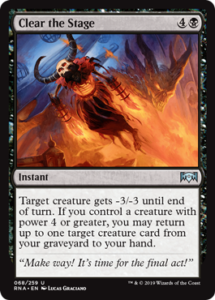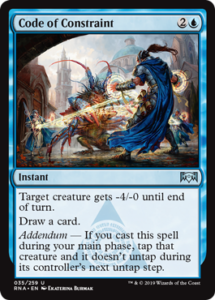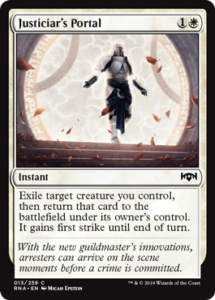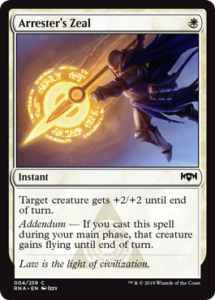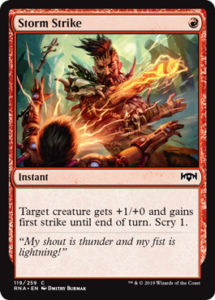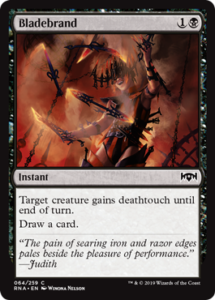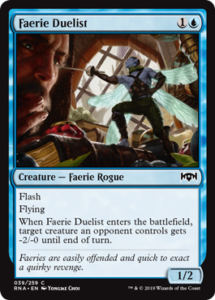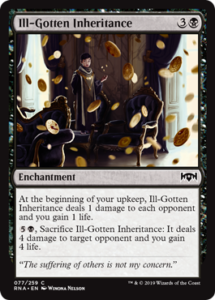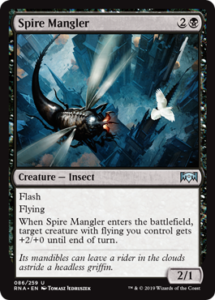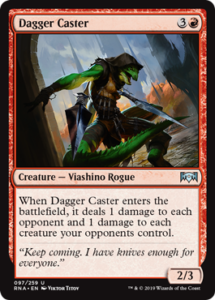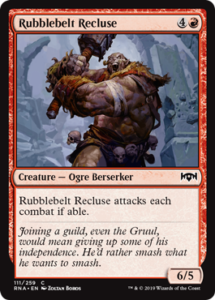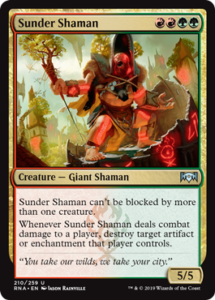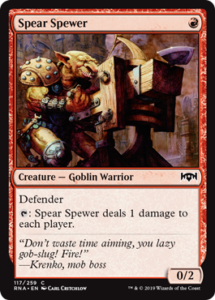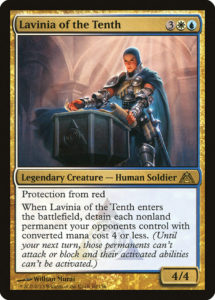Ravnica Allegiance prerelease is coming up this weekend, and we finally have the full set spoiler to peruse! We’ve already gone over the set mechanics, but there are a wealth of individual designs and patterns to examine. The set seems to have fairly high complexity, with a whole host unique cards, cards with many lines of text, and cards which are archetypes unto themselves. Let’s start with this last category: the engine cards.
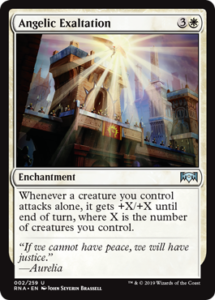
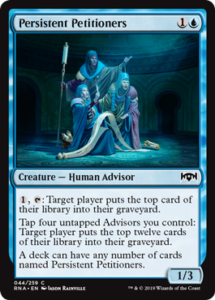
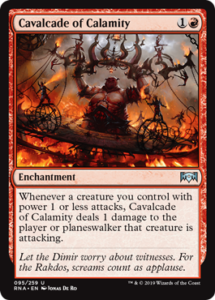
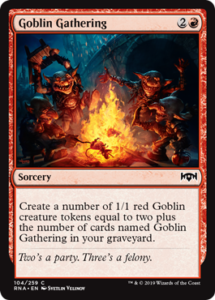
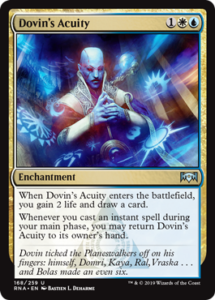
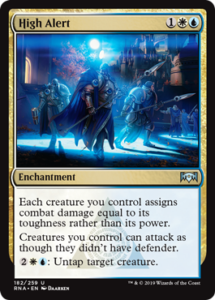
Engine Cards
One of the best ways to give a Limited environment longevity is including build-around cards that don’t directly relate to the set’s themes. This provides additional ways to approach a draft, additional challenges and achievements, and allows us to play fun shenanigans decks.
Khans of Tarkir had a Prowess theme which went well with Goblinslide, but Goblinslide was a pretty lousy card unless you dedicated your draft to making it function. Pyroconvergence and Hold the Gates were pretty weak engines in Return to Ravnica and Gatecrash, but they provided different things to value and could pay off big-time. Some engines were more mainstream, as cards like Burning Vengeance and Secret Plans did exactly what their color combinations wanted to do (but weren’t necessary for them to function). Other engines were more subtle, like Chief of the Edge supporting Khan’s non-wedge warrior theme or Legion Conquistador, Squadron Hawk, and Coldsnap’s Ripple spells as single-card engines.
Generally, formats have one to three engines or alternative styles of decks. Ravnica Allegiance has six. Angelic Exaltation takes half the power away from the insane mythic rare Sublime Archangel, but still leaves plenty of power for go-wide decks. Cavalcade of Calamity shaves a mana (and half the effectiveness) off Raid Bombardment and supports hyperaggressive go-wide red decks (perhaps even letting players draft Boros aggro). Goblin Gathering not only enables Cavalcade of Calamity but is the next in the long line of Kindles and Squadron Hawks that reward you for drafting the same card. Persistent Petitioners is the first non-black card to have the “Relentless Rats” ability and the second draft-all-the-copies common. There’s Dovin’s Acuity (aka Information Campaign), a weaker twist on Disinformation Campaign that nevertheless can have an entire deck built around it. And finally there’s High Alert, which just like Assault Formation and Doran, the Siege Tower allows a deck to evaluate its creatures completely differently.
This is a lot of alternative options and a lot of additional complexity to keep in mind. For a normal set, this might be overwhelming, but in Ravnica, where only five color pairs (and the five arcs of their intersections) are supported, this could be exactly what the doctor ordered. My biggest complaint with Guilds of Ravnica was the lack of options (and accordingly, replayability), and more alternative strategies is a great potential step towards fixing that in Ravnica Allegiance.
Suddenly Temur, is Standing Beside You
It’s quite common for old mechanics to show up on one-off cards. Tireless Tracker has Landfall, Gearseeker Serpent has Affinity for Artifacts, and Haaza Marshal has Battalion, but those keywords/ability words weren’t actually printed on them. This is smart design: Wizards gets to use old ideas in new ways, holes are filled from an existing knowledge base, and those mechanics’ fans get a gift when normally non-evergreen (and deciduous) mechanics don’t reappear for many, many years.
If a mechanic shows up on more than a couple cards, it’s usually a subtheme. There were four warriors-matter cards in Khans of Tarkir (all in WB) and four Gates-matter cards in Guilds of Ravnica (one blue, one Boros, and two artifacts, which makes sense considering it’s the play-all-the-colors archetype). Heck, Ravnican mechanics are often narrow—there are only ten cards with Jump-start, Haunt, or Radiance and only nine with Forecast, meaning major mechanical themes don’t actually have to show up that much.
Well, we’ve got the makings of a Ferocious subtheme, spread across four cards in Gruul and Rakdos: Clear the Stage, Undercity’s Embrace, Flames of the Raze-Boar, and Territorial Boar. On the three instants, Ferocious is functioning like Kicker, an odd choice when Spectacle is functioning like Kicker (when it’s not reducing mana costs). Those three cards only require a big creature once, so there’s not much of a deckbuilding constaint or archetype there, but then Territorial Boar encourages you to play as many big creatures as possible. There’s no real problem here. It just feels weird that these cards all suggest a theme exists, don’t agree about what the theme means for deckbuilding, and then that has no support anywhere else. It reminds me of Skirk Prospector and Goblin Warchief in Dominaria, which tricked a lot of less-experienced drafters into believing that there was a goblins deck.
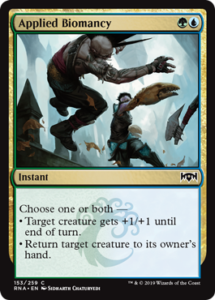
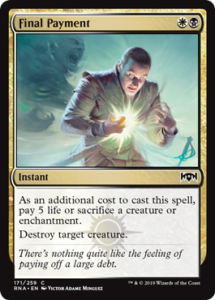
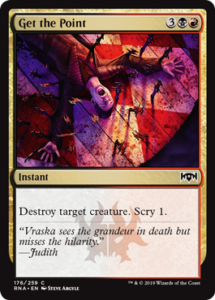
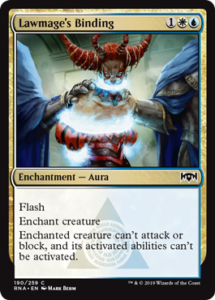
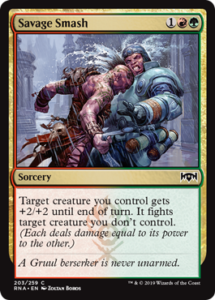
Guild Removal
In Guilds of Ravnica, three of the five guilds got common multicolor removal. Hypothesizzle and Artful Takedown were outstanding, but Undercity Uprising was very, very weak. In Ravnica Allegiance, every guild gets a great common removal spell. This is a wonderful development. These spells are powerful enough to entice players to take them highly but too difficult to splash unless you’re in an adjacent guilld, plus three of them require at least some deckbuilding concessions to function (Lawmage’s Binding is just amazing and Get the Point is similarly solid, though a tad weaker).
As a dedicated Simic mage, Applied Biomancy is all I could’ve hoped for and a bag of pretzel-cookie dough-squid-chips. It’s a huge tempo blowout that provides a bit of extra damage and sometimes eats a creature, too. It’s the perfect play to press an early advantage or stall for Adapt to come online. The rest of the cycle is similarly sweet and bears discussing, but I’d like to focus on the oddest one.
Lawmage’s Binding is a bit surprising. Arrest has wavered between common and uncommon, so seeing it here as a multicolor common with upside makes sense. However, I really would’ve expected Lawmage’s Binding to be a Stasis Snare rather than a Pacifism. Yes, Stasis Snare is slightly more powerful since it prevents sacrifice-plus-Afterlife shenanigans and static/triggered abilities, but Stasis Snare cleanly removes a creature from combat. There has never before been an instant-speed Pacifism,* and for good reason—such a card won’t remove a creature from combat even though it looks like it would. I think it’s dangerous for designers to give players tools that are easy to shoot themselves in the foot with, particularly at common.
*Yes, Temporal Isolation is close, but first, it was from Time Spiral, and secondly it works on an attacking or blocking creature.
There are still plenty of cards to go over, so let’s do some rapid fire reviews!
Every other card with Addendum gives you a choice of an additional effect. Code of Constraint instead gives you a different spell. That’s an odd choice when Spectacle is already wavering between being Kicker and Delve.
I love it. You blink the creature so fast it arrives seconds beforehand with a tiny bit of information about the future. Really nice to see another two mana blink with upside.
This is great, too! I love me a W +2/+2 instant with upside, and being a sorcery speed Mighty Leap when you need to get in damage is pretty big upside.
I thought Kindled Fury was about as much power as Wizards would pack into a R combat trick, but I was wrong. Getting fractional card advantage with a one mana combat trick is a big game.
It’s starting to feel a bit like Invasion with so many cards cantripping. That said, I’m surprised it’s taken so long for this spell to be printed.
Nothing slows a creature down like a toothpick to the eye. This card seems weak, but it’s going to lead to some exciting moments; and it’s good at eating Orzhov spirits and triggering Spectacle in Temur decks.
Spells with repeatable upkeep triggers tend to be uncommon nowadays and I’m pretty surprised this Spectacle-enabler (and Orzhov Extortion win-con) isn’t.
I’m more confused by the design and flavor of this card than I am Kraul Harpooner‘s, but it definitely has a bunch of play to it.
Sometimes you get to see the power differential between a pushed, color-intensive rare and a reasonable but powerful uncommon. This is good, fair, and telling of just how powerful Goblin Chainwhirler is.
For a simple card, this is among the more shocking designs in the set. This ogre is massive. Red generally gets 6/4s for six mana and 6/1s at this cost. I wonder if the rules for common creatures have changed and now every color (but white) has access to huge common creatures.
Nightveil Predator is ridiculous, and so is Sunder Shaman. A four mana 5/5 Trygon Predator is already a big beating, but this is almost impossible to trade with in combat (there are three common cards with Deathtouch). Gruul already has a bunch of undercosted beaters, but this one takes the cake. And the bakery. And the twenty buildings nearby. And their artifacts and enchantments. All in single combat.
And for our final design of the day, let’s look at something wonderfully simple. Spear Spewer is great in aggro, fantastic at triggering Spectacle, has excellent flavor, and is more accurate to Lobber Crew‘s flavor text than Lobber Crew itself.
Ravnica Allegiance has a whole host of sweet designs, from Temur throwbacks and six engine cards to a blink effect evocative of Minority Report and a powerful twist on Goblin Fireslinger. I’m quite excited to play some RNA this weekend and to prep for MagicFest New Jersey the following weekend.
And, as always, thanks for reading.
—Zachary Barash is a New York City-based game designer and the commissioner of Team Draft League. He designs for Kingdom Death: Monster, has a Game Design MFA from the NYU Game Center, and does freelance game design. When the stars align, he streams Magic.
His favorite card of the month is Growth Spiral. Explore is one of his favorite designs ever, and this is not only the same card, but it avoids the complexities of playing extra lands. Also, have you seen that artwork by Seb McKinnon?


